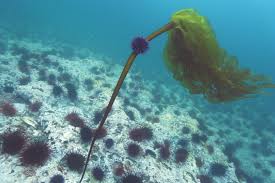In this activity, students learn about the role of Sea Otters in their coastal habitat, through an interactive story.
Kelp forests are undersea forests made of seaweed instead of trees. Many types of fish live in kelp forests, finding shelter and reliant on the kelp to lay their eggs on. Crabs, sea urchins, snails, clams, shrimp, sea stars, and other invertebrates are also found in kelp forest environments.
Sea otters play a very important role in keeping kelp forest ecosystems healthy.
The sea otter is an example of an important keystone species (a species that, if removed, has a great effect on other species and can cause collapse of the food web).
Sea otters find all their food and shelter in kelp forests. These large members of the weasel family love to eat sea urchins and crabs, often using a rock as a tool to crack the animals' hard shell. When not eating, they wrap the ends of the anchored kelp fronds around themselves and sleep floating on the surface, like fastening a seat belt. Baby otters "wear a seat belt" to prevent them from floating away while their mother's dive for food in the kelp forest.
Even though sea otters live their whole lives in cold Pacific waters, they don't get cold. Other marine mammals have evolved blubber to keep warm; instead of this fatty layer, sea otters have some of the thickest hair of any animal. This dense fur traps a layer of air to keep their skin dry and warm when properly clean and groomed. Sea otters may have up to a billion hairs in their coats, compared to the average person who has about 10,000 hairs on their entire head.
In the 1700s and 1800s, sea otters were hunted for this thick fur coat, until there were no more sea otters found on the BC coast. When this keystone species was removed, populations of many organisms were effected, and everything changed. Sea otters had kept kelp forests healthy by eating animals that graze on (eat) kelp. Sea urchins are voracious consumers of kelp, and with nothing to eat urchins, they feed uncontrollably and destroy kelp forests. In coastal areas where there are no sea otters, there has been a change from forests to deserts, or "urchin barrens", and many fish and other creatures are without protective homes, breedng grounds, juvenile nurseries or food sources.
